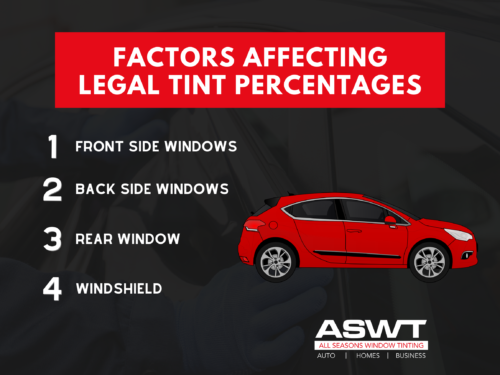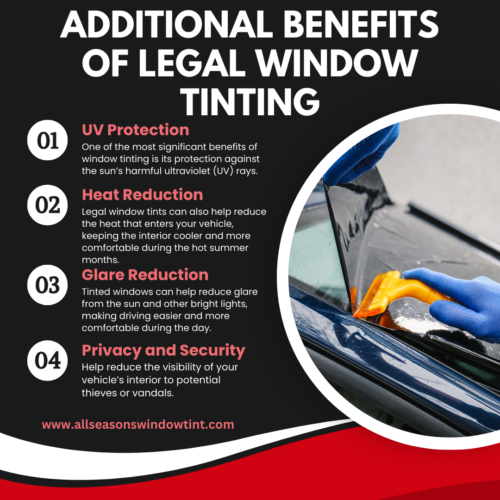Window tint laws vary drastically by state, making the process confusing. At All Seasons Window Tint, we’re here to help you navigate the world of the darkest legal tint percentage regulations.
Let’s delve into the specifics of the darkest legal tint percentages.
We’ll explore the different window types, factors influencing tint laws, and how to achieve the perfect balance between legal compliance and the benefits of window tinting.
Experience the difference with our professional, high-quality tinting solutions for your vehicle or building. Contact All Seasons Window Tint today for a free consultation and quote!
Darkest Legal Tint Percentage Allowed by Law
When it comes to window tinting, many drivers want their windows to be as dark as possible for maximum privacy, style, and protection from the sun’s harmful rays.
But before you start choosing the darkest legal tint percentage, it’s essential to understand the laws and regulations surrounding window tint darkness.
Understanding Window Tint Percentages
Window tint percentages refer to the amount of visible light that can pass through the tinted window.
The lower the percentage, the darker the tint. For example, a 5% tint is much darker than a 50% tint.
In the United States, each state has laws regarding the darkest legal tint allowed on a vehicle’s windows.
These laws are put in place to ensure the safety of drivers, passengers, and law enforcement officials.
State-Specific Tint Laws
It’s crucial to familiarize yourself with your state’s specific car window tint laws before having your windows tinted.
In California, for example, the darkest legal tint allowed on the front side windows is 70%, while there are no restrictions on the darkness of the back and rear windows.
Other states, like here in Dallas-Forth Worth, Texas, allow a minimum of 25% visible light transmission on the front side windows and darkness on the back side and rear windows, provided the vehicle has side mirrors.
Penalties for Violating Tint Laws
Failing to comply with your state’s window tint laws can result in hefty fines, legal penalties, and even the requirement to remove the illegal tint at your own expense.
In some cases, excessively dark tints can lead to a traffic stop and a citation from law enforcement.
To avoid these consequences, it’s best to avoid caution and choose a tint percentage that falls within your state’s legal limits.
If you’re unsure about your area’s specific laws, consult a professional window tint installer or your local DMV.
Factors Affecting Legal Tint Percentages
When determining the legal window tint darkness for your vehicle, several factors must be considered, including the specific windows you plan to tint and the purpose of the tinting.
 Front Side Windows
Front Side Windows
The front side windows in most states are subject to the strictest tint regulations.
Excessively dark tints on these windows can impair the driver’s visibility and pose a safety risk.
Typically, states require a minimum of 50-70% visible light transmission on the front side windows.
Back Side Windows
The back side windows often have more lenient tint regulations than the front. Some states allow any level of darkness on the back side windows, while others require a minimum visible light transmission of 20-35%.
Rear Window
The rear window often has more flexible tint laws than the back-side windows. However, some states require the vehicle to have dual side mirrors if the rear window is tinted below a certain percentage of visible light transmission.
Windshield
Most states prohibit any aftermarket tint on the windshield, with the exception of a small visor strip at the top. This visor strip typically cannot extend more than 5 inches from the top of the windshield and must allow at least 70% visible light transmission.
Medical Exemptions for Window Tinting
Individuals with certain medical conditions may be exempt from their state’s window tint laws.
These medical exemptions often apply to people with light-sensitive conditions, such as lupus or albinism, who require darker window tints to protect their skin and eyes from the sun’s harmful rays.
To qualify for a medical exemption, you must provide documentation from a licensed physician stating your medical condition and the need for darker window tints.
Some states require a minimum visible light transmission for medically exempt tints, such as 20-25%.
It’s important to note that even with a medical exemption, your window tints must still allow a clear view of the vehicle’s interior from the outside.
This is to ensure the safety of law enforcement officials during traffic stops and other interactions.
Enforcement of Window Tint Laws
Local and state law enforcement agencies enforce window tint laws to ensure the safety of all drivers on the road. Police officers use various methods to determine if a vehicle’s window tints comply with state regulations.
Traffic Stops
One of the most common ways window tint laws are enforced is through traffic stops.
If a police officer suspects your window tints are too dark, they may pull you over to inspect them and issue a citation if necessary.
Tint Meters
Law enforcement officials use specialized devices called tint meters to accurately measure the visible light transmission of a vehicle’s window tints.
These meters provide a precise reading of the tint percentage and help determine if the tints fall within the legal limits.
Fines and Penalties
If your vehicle’s window tints are found to violate state laws, you may face fines, court fees, and other penalties.
In some cases, you may also be required to remove the illegal tints at your own expense. To avoid these consequences, it’s crucial to ensure that your window tints comply with your state’s regulations before driving.
If you’re unsure about your tints’ legality, consult a professional window tint installer or your local law enforcement agency.
Additional Benefits of Legal Window Tinting
While the primary purpose of window tinting laws is to ensure the safety of drivers and law enforcement officials, there are several additional benefits to choosing a legal tint percentage for your vehicle.
 UV Protection
UV Protection
One of the most significant benefits of window tinting is its protection against the sun’s harmful ultraviolet (UV) rays.
Even legal tint percentages can block up to 99% of UV rays, helping to prevent skin damage, premature aging, and even skin cancer.
Heat Reduction
Legal window tints can also help reduce the heat that enters your vehicle, keeping the interior cooler and more comfortable during the hot summer months.
This can also help reduce the workload on your vehicle’s air conditioning system, potentially improving fuel efficiency.
Glare Reduction
Tinted windows can help reduce glare from the sun and other bright lights, making driving easier and more comfortable during the day.
This can be especially beneficial for drivers who spend long hours on the road or those with light-sensitive eyes.
Privacy and Security
While the darkest legal tints may not provide complete privacy, they can still help reduce the visibility of your vehicle’s interior to potential thieves or vandals.
This added level of security can provide peace of mind when parking your vehicle in public areas.
When choosing a legal window tint percentage for your vehicle, it’s essential to consider these additional benefits and how they align with your specific needs and preferences.
By selecting a tint that complies with state regulations while providing the desired level of protection, comfort, and style, you can enjoy all the benefits of window tinting without the risk of legal consequences.
FAQs about Darkest Legal Tint Percentage
Is 20% or 35% tint darker?
20% tint is darker, letting less light in. It means more shade inside your ride.
Is 5% tint legal in Texas?
Nope, Texas window tint laws says no to 5%. They stick to a minimum of 25% for the front side windows.
What’s the most darkest legal tint?
The max dark varies by state. Some allow as low as 5%, but that’s rare and usually not for all windows.
How dark is the darkest legal tint?
In some places, you can go down to a super stealthy 5%. But remember, it depends on where you’re driving.
Cruise in Comfort & Style: Mastering Darkest Legal Tint Percentage for Your Car
While navigating the darkest legal tint percentage laws can be complex, you can now make informed choices about your car’s window tint.
Remember, each state has its own regulations, so double-check before getting your windows tinted.
Additionally, if you have a medical condition requiring a darker tint, don’t forget to obtain the necessary exemption form.
With window tint, you can protect yourself from UV rays, enjoy a more relaxed car on hot days, and enhance privacy.
Stay within legal limits, and you’ll be cruising comfortably and stylishly in no time. So, find your state’s darkest legal tint percentage and start reaping the benefits of a well-tinted ride!
Enhance your space or vehicle’s comfort, style, and efficiency with All Seasons Window Tint.
Start your project with a team committed to the highest quality and customer satisfaction standards. Contact us now for a free quote!

